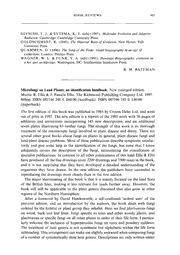
Microfungi on Land Plants: an identification handbook. New enlarged edition. Martin B. Ellis & J. Pamela Ellis PDF
Preview Microfungi on Land Plants: an identification handbook. New enlarged edition. Martin B. Ellis & J. Pamela Ellis
BOOK REVIEWS 463 GIVNISH, T. J. & SYTSMA, K. J. (eds) (1997). Molecular Evolution and Adaptive Radiation. Cambridge: Cambridge University Press. GOLDSCHMIDT, R. (1940). The Material Basis of Evolution. New Haven: Yale University Press. QUAMMEN, D. (1996). The Song of the Dodo: island biogeography in an age of extinctions. London: Pimlico Press. WAGNER, W. L. & FUNK, V. A. (eds) (1995). Hawaiian Biogeography: evolution on a hot spot archipelago. Washington, DC: Smithsonian Institution Press. R. M. BATEMAN Microfungi on Land Plants: an identification handbook. New enlarged edition. Martin B. Ellis & J. Pamela Ellis. The Richmond Publishing Company Ltd. 1997. 868pp. ISBN 085546 246 9. £60.00 (hardback). ISBN 085546 245 0. £40.00 (paperback). The first edition of this book was published in 1985 by Croom Helm Ltd, and went out of print in 1992. The new edition is a reprint of the 1985 work with 36 pages of additions and corrections incorporating 143 new descriptions, and an additional seven plates illustrating 83 further fungi. The strength of this work is its thorough treatment of the microscopic fungi involved in plant disease and decay. There are several other good books about fungi on plants in general, plant disease fungi and land-plant disease problems. Most of these publications describe symptoms satisfac- torily and give some help in the identification of the fungi, but none that I know adequately covers the description of the fungi, necessitating the consultation of specialist publications. In contrast to all other publications of this kind Ellis & Ellis have produced all the line drawings (over 2200 drawings and 3500 taxa) in the book, and it is not surprising that they have developed a detailed understanding of the organisms they have drawn. In the new edition the publishers have succeeded in reproducing the drawings more clearly than in the first edition. The major shortcoming of this book is that it is mainly focused on the land flora of the British Isles, making it less relevant for lands further away. However, the book will still be applicable to the plant genera discussed that also grow in other regions of the Northern Hemisphere. After a foreword by David Hawksworth, a self-confessed 'ardent user' of the previous edition, and an introduction by the authors, the book deals with fungi ordered by the habitat or plant group they inhabit. Here we find plurivorous fungi on wood, bark and leaf litter, fungi specific to trees and other woody plants, and plurivorous or specific fungi on all other plants in order of their life form. I particu- larly welcome the inclusion of hyperparasitic fungi on rusts and powdery mildews. The treatment of host genera is not systematic but alphabetic within the life form subheading. This arrangement can make use slightly awkward when comparing fungi of a number of systematically close host genera. Descriptions are only written under 464 BOOK REVIEWS one host genus, and may be referred to several times on other hosts; it would have helped if page references had been included in the text. For genera (or groups of genera, for plurivorous fungi) with numerous known fungal partners the entries are arranged by plant part affected. Where fewer fungi are known this distinction is not made. The potential fungi are listed in a pragmatic order, sometimes with systematic subheadings, where a number of fungi from one higher taxon are considered for any host. This approach can be confusing to the inexperienced user, as some previous knowledge of fungal systematics and symptom structure is necessary to find one's way around. This is exacerbated by the lack of even common synonyms. After the descriptions, and in this edition the additions and corrections, the book contains 213 plates of ink drawings by the authors. In my opinion, this is the strongest part of the publication although the scale of the drawings is not immediately obvious. The drawings are arranged in parallel order to the text, and my criticisms of this arrangement are the same as above. The book is concluded by some recommended books (unfortunately not including similar works by other authors), useful addresses, a glossary and both fungus and host-plant indices. The relatively short time in which the previous edition has been in print is proof of the popularity and usefulness of this work. Anyone who works with plants or fungi on plants and has not already got the first edition will want to use this new enlarged 'Ellis'. People owning the first edition will probably wish to swap it for the new edition because of the additions, corrections, and the clearer print of the plates. S. HELFER John Lindley, 1799-1865, Gardener-Botanist and Pioneer Orchidologist. Edited by W. T. Stearn. Woodbridge, Suffolk: Antique Collectors' Club with the Royal Horticultural Society. 1999. 232pp, 43 colour plates, 29 b/w figures. ISBN 1 85149 296 8. £29.50 (hardback). This handsome book makes no claim to be a scholarly biography, but presents a fascinating series of articles about the life and work of a remarkable 19th-century botanist in the year of the bicentenary of his birth. Although Lindley's achievements and energy make almost exhausting reading, the production of such a popular account is long overdue, because he is by no means as well known (to non- orchidologists) as contemporaries such as Robert Brown or the Hookers. The topics covered are diverse. The ever-productive Professor Stearn starts with an admirable outline of Lindley's life and work - an expansion of an earlier article in the light of significant new material recently discovered in British Columbia in the family archive of one of Lindley's daughters. Two lectures given by Lindley himself are reproduced: the first his inaugural lecture as Professor of Botany at University College London. He was appointed to this chair in 1828, the same year
